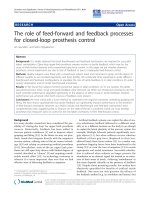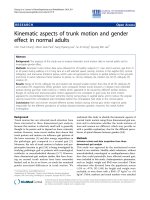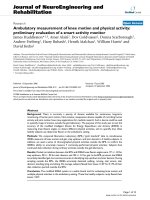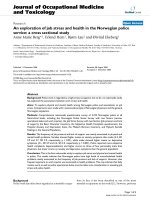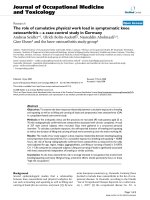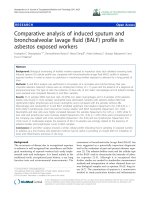Báo cáo hóa học: " Thermal conductivity of carbon nanotubes and graphene in epoxy nanofluids and nanocomposites" pptx
Bạn đang xem bản rút gọn của tài liệu. Xem và tải ngay bản đầy đủ của tài liệu tại đây (2 MB, 16 trang )
This Provisional PDF corresponds to the article as it appeared upon acceptance. Fully formatted
PDF and full text (HTML) versions will be made available soon.
Thermal conductivity of carbon nanotubes and graphene in epoxy nanofluids
and nanocomposites
Nanoscale Research Letters 2011, 6:610 doi:10.1186/1556-276X-6-610
Mario Martin-Gallego ()
Raquel Verdejo ()
Mohamed Khayet ()
Jose Maria Ortiz de Zarate ()
Mohamed Essalhi ()
Miguel Angel Lopez-Manchado ()
ISSN 1556-276X
Article type Nano Express
Submission date 19 August 2011
Acceptance date 1 December 2011
Publication date 1 December 2011
Article URL />This peer-reviewed article was published immediately upon acceptance. It can be downloaded,
printed and distributed freely for any purposes (see copyright notice below).
Articles in Nanoscale Research Letters are listed in PubMed and archived at PubMed Central.
For information about publishing your research in Nanoscale Research Letters go to
/>For information about other SpringerOpen publications go to
Nanoscale Research Letters
© 2011 Martin-Gallego et al. ; licensee Springer.
This is an open access article distributed under the terms of the Creative Commons Attribution License ( />which permits unrestricted use, distribution, and reproduction in any medium, provided the original work is properly cited.
- 1 -
Thermal conductivity of carbon nanotubes and graphene in epoxy nanofluids
and nanocomposites
Mario Martin-Gallego
1
, Raquel Verdejo
1
, Mohamed Khayet
2
, Jose Maria Ortiz de
Zarate
2
, Mohamed Essalhi
2
, and Miguel Angel Lopez-Manchado*
1
1
Instituto de Ciencia y Tecnologia de Polimeros, ICTP-CSIC, Juan de la Cierva 3,
Madrid, 28006, Spain
2
Faculty of Physics, Complutense University, Madrid, 28040, Spain
*Corresponding author:
Email addresses:
MMG:
RV:
MK:
JMOZ:
ME:
MALM:
- 2 -
Abstract
We employed an easy and direct method to measure the thermal conductivity of
epoxy in the liquid (nanofluid) and solid (nanocomposite) states using both rodlike
and platelet-like carbon-based nanostructures. Comparing the experimental results
with the theoretical model, an anomalous enhancement was obtained with multiwall
carbon nanotubes, probably due to their layered structure and lowest surface
resistance. Puzzling results for functionalized graphene sheet nanocomposites suggest
that phonon coupling of the vibrational modes of the graphene and of the polymeric
matrix plays a dominant role on the thermal conductivities of the liquid and solid
states.
Keywords: carbon nanotubes; graphene; nanocomposites; nanofluids; thermal
conductivity.
PACS: 74.25.fc; 81.05.Qk; 81.07.Pr.
Introduction
Due to the increasing importance of energy dissipation in the electronic industry,
thermal conductivity of cured epoxy resins has been widely investigated over the
years. One strategy to improve the thermal transport of epoxy resins has been the
addition of highly conductive fillers, such as carbon-based or metallic fillers [1].
However, the effect of such additions on either the uncured system or the cure
reaction of resins has not yet been fully established. The thermal conductivity of the
uncured liquid resin plays an important role to define the variables involved in the
transformation process, such as time, applied heat, or cooling time, which will then
have a profound effect on the cross-link density and hence, on the final properties of
the system. Thus, we aimed at studying the effect of two types of carbon-based
nanofillers, in particular, nanotubes and graphene sheets, on the thermal conductivity
of an uncured liquid epoxy resin.
There have been considerable interest and effort in the transport properties of
carbon nanotube [CNT] filled polymer nanocomposites [2, 3]. Electrical conductivity
of epoxy nanocomposites increases by several orders of magnitude with CNT
concentration [4]; this effect can be explained by the established percolation theory
[5] with the shift from an insulator into a conductive material when a critical
concentration of the conductive filler is reached, commonly known as percolation
threshold. However, the thermal conductivity has shown at best linear enhancements
with nanotube content with a lack of thermal percolation. The main reason for this
fact is the relatively small thermal conductivity ratio (K
cnt
/K
matrix
) by comparison with
the corresponding ratio of electrical conductivities [6].
Graphene is a two-dimensional carbon nanofiller with a one-atom-thick sheet of sp
2
bonded carbon atoms that are densely packed in a honeycomb crystal lattice [7, 8].
Single layer graphene is predicted to have a remarkable performance, such as high
thermal conductivity of 5,000 W/mK, which corresponds to the upper bound of the
highest values reported for single-walled carbon nanotube bundles [9], high electrical
conductivity of up to 6,000 S/cm [10], and superior mechanical properties with
Young's modulus of 1 TPa and ultimate strength of 130 GPa [11]. In addition to these
outstanding properties, the recent developments on graphene synthesis routes and on
- 3 -
the understanding of their unique properties have prompted the development and
study of graphene filled nanocomposites [12, 13].
This communication analyzes the epoxy-nanofiller blend in the liquid state as a
nanofluid and takes into consideration the current theories to explain its transport
properties, particularly, the thermal conductivity. Some studies report large thermal
enhancements by adding a small percentage of nanoparticles to a fluid [14].
This
anomalous behavior, far away from the predicted data by standard theoretical models,
is explained by several physical mechanisms like the Brownian motion of the particles
or changes in the distribution of the molecules in the liquid state at the particle/liquid
interface [15].
Methods
Materials
Diglycidyl ether of bisphenol-A epoxy resin (product number: 405493),
diethylene triamine curing agent (D93856), and single-walled nanotubes [SWNTs]
(519308; diameter 1.2 to 1.5 nm; length 2.5 µm; and specific surface area 1,300 m
2
/g)
used in this study were purchased from Sigma-Aldrich (St. Louis, MO, USA), while
multiwalled nanotubes [MWNTs] (diameter 40 nm; length 120 µm, and specific
surface area 250 to 300 m
2
/g) were synthesized in-house by a chemical vapor
deposition technique [16]. These MWNTs were then functionalized [f-MWNT] with a
3:1 concentrated H
2
SO
4
/HNO
3
mixture refluxed at 120°C for 30 min and thoroughly
washed with distilled water until neutral. Functionalized graphene sheets [FGS] were
also synthesized in-house by the rapid thermal expansion of graphite oxide [GO] at
1,000 °C under an inert atmosphere. This results in a high surface area carbon
material consisting of graphene layers with residual hydroxyl, carbonyl, and epoxy
groups. GO was synthesized from natural graphite flakes obtained from Sigma-
Aldrich (St. Louis, MO, USA; universal grade, purum powder ≤ 0.1 mm, 200 mesh,
99.9995%), according to the Brödie method. Full characterization of the FGS used in
this work is described elsewhere [17].
Sample preparation and characterization
Nanoparticles were mixed under high shear in the resin for 8 h at room
temperature to ensure a homogeneous dispersion. The thermal conductivity of the
uncured nanofluids (the samples do not contain the curing agent) was measured with a
KD2 probe (Decagon Devices Inc., Pullman, WA, USA), based on the hot wire
technique, and consisting of a needle located inside the sample. As can be seen in the
experimental setup (Figure 1), the hot wire enabled us to obtain the thermal
conductivity in a direct and easy way. The needle had a waiting time of 30 s until the
sample temperature was stable and heated up the sample for 30 s. Then, it was used to
monitor the cooling rate and calculate the thermal conductivity with an accuracy of
5%. The measurements were carried out over a temperature range from 30°C to 60°C.
In this range of temperature, no convection was present in the liquid. The results were
the average of at least six measurements for each sample. On the other hand, the
thermal conductivity of the cured samples was measured using a hot disk apparatus.
This method was based on a heat balance in the steady state between the sample and
the three disks of the apparatus that allowed us to calculate the thermal resistivity of
- 4 -
the solid sample. Testing samples with different thicknesses were used to obtain the
thermal conductivity of the material. The next protocol was followed to cure the
formulations: the liquid formulations containing nanoparticles and epoxy resin were
mixed with diethylene triamine in a stoichiometric ratio; the blends were degassed for
10 min in a vacuum chamber and casted in Teflon molds. Thermal treatments of 60
min at 70°C and 90 min at 130°C were applied to complete the curing reaction [18].
The morphology of the samples was observed using a Philips Tecnai 20 (Philips,
Amsterdam, The Netherlands) transmission electron microscope at an acceleration
voltage of 200 kV.
Results and discussion
In Figure 2, we show the morphology of the uncured formulations with the highest
concentrations of MWNT and FGS by transmission electron microscopy [TEM]
analysis. In both cases, a homogeneous dispersion state was obtained.
The thermal conductivity [K] of CNTs depends on several factors such as the
morphology, the chirality, the diameter and length of the tubes, the number of
structural defects, and the specific surface area [19, 20]. Thus, a description of the
thermal conduction mechanisms is nontrivial. Liu et al. [21] reported a K for a SWNT
and a MWNT of 2,400 W/mK and 1,400 W/mK, respectively, measured using the non
contact Raman spectra shift method. The lower intrinsic conductivity of MWNTs was
assigned to the fact that thermal transport mainly occurs by the outermost wall and by
the existence of intertube Umklapp scattering processes. In addition, SWNTs exhibit a
higher number of phonon vibrational modes and a lower defect density in relation to
MWNTs, leading to a higher intrinsic K [22, 23]. CNTs are characterized by a large
aspect ratio and a huge surface area. It is assumed that the K of CNTs will be higher
for CNTs with a greater aspect ratio [24]. In this study, both CNTs exhibit a similar
aspect ratio, so this issue does not seem to affect the K of the nanofluid. Another
factor that determines the K of CNTs is the presence of structural defects. Che et al.
[25] revealed that the K of CNTs decreased with increasing defect concentration.
Finally, the heat transfer mechanism of CNTs takes place with phonons and electrons
and depends on their chirality [1]. However, to simplify the discussion, we assumed
that the thermal conductance mainly occurs via a phonon conduction mechanism
since the aim of this article is to provide a general description of the experimentally
determined K.
Table 1 presents the K measurements of the nanofluids only at 30°C as no
significant changes with the temperature were observed. The results indicate that
MWNTs are the most effective carbon nanofillers to improve the K of liquid resins.
Indeed, the K of the nanofluids gradually increased as a function of MWNT content,
reaching a 70% improvement at 1 wt.% loading. The better performance of MWNTs
can be due to their lower specific surface area [SSA], as compared with SWNTs, and
to the presence of the internal layers which enable phonon conduction and hence
minimize coupling losses. K of nanocomposites is sensitive to the quality of the
interfacial bonding between the filler and the matrix, intimately related to a phonon
coupling mechanism. This mechanism is influenced by numerous factors such as the
length of free path for phonons, the boundary surface scattering, the number of
vibration modes, and the resistance to heat flow at the interface, known as Kapitza
resistance [26]. In general, the Kapitza resistance increases with the SSA, decreasing
the efficiency of phonon transport.
- 5 -
A lower improvement was obtained with the acid-treated carbon nanotubes (f-
MWNTs), even though the functionalization decreases the SSA of the nanotubes. This
result can be explained by the presence of the functional groups, hydroxyl and
carbonyl, that act as scattering points on the surface where phonons can be transferred
from the nanotube crystalline structure into the insulating polymer matrix. This
behavior has already been observed in cured resins [27, 28], but not in the pre-cured
state.
The addition of nano-dispersed FGS caused no improvement of the K in the liquid
resin. To better understand this result, we also measured dispersions of both the
starting natural graphite and GO. The natural graphite showed a slight enhancement
of K, while no improvement was observed in the oxidized system. These results
support the previous discussion of the negative effect of the presence of functional
groups on the nanoparticle surfaces [29],
the presence of only one carbon layer, and
the large SSA (see Figure 3). Hence, FGS cannot be considered as suitable fillers to
enhance the K of liquid resins.
The enhancement in the K of MWNT nanofluids were fitted with the Hamilton-
Crosser [30] model (Equation 1) traditionally used to predict the thermal enhancement
of solid/liquid suspensions:
(
)
( ) ( )
e
f
1
1
1 1
n
K
K n
α φ
α α φ
−
= +
+ − − −
,
(1)
where K
e
and K
f
are the effective thermal conductivities of the suspension and the
base fluid, respectively;
p
f
K
K
α
= is the K ratio, K
p
is the particle conductivity, n is the
particle shape factor (n = 6 for cylinders, n = 3 for spheres in which case, Equation 1
reduces to the Maxwell model), and φ is the particle volume fraction calculated using
the true density of the nanotubes [31]. The theoretical thermal conductivities are
calculated with both values due to the bent conformation adopted by CNTs when
dispersed in a matrix; thus, their shape factor would be between 3 and 6. Figure 4
compares the experimental results for the MWNT samples with the theoretical ones
from the proposed model.
We observe an anomalous enhancement of the experimental K. This behavior
could be related to two effects. The first effect is the presence of an organized
structure of the molecules in the liquid state at the solid/liquid interface that facilities
the coupling between the solid particles and the fluid [32]. The second effect could be
contributions from the Brownian motions of the particles that modify the heat transfer
in the fluid [33].
We finally measured the K of the cured samples for some of the nanocomposites
with a classical hot-plate apparatus. TEM microphotographs show a finely and
homogeneous dispersion of the carbon nanostructures, MWNTs, and FGS in the cured
epoxy samples (Figure 5). The improvements obtained for the cured MWNT
nanocomposites are approximately the same as those in the liquid state and are in
agreement with the data found in the literature [27, 28, 34].
The cured FGS sample
revealed a similar enhancement of the K as the MWNT sample. This increase of K in
- 6 -
cured epoxy resin due to the addition of FGS has already been reported [35, 36], but
not the uncured/cured transition. This transition suggests that the results can be
attributed to the differences in the media surrounding the nanoparticles when the resin
is in the liquid or solid state. While the FGS are dispersed in a liquid media, they are
not able to transfer the heat because the vibrational modes are not compatible.
However, when the FGS are surrounded by the more rigid cured matrix, the
differences between the frequencies of vibrational modes are smaller and enable
phonon coupling. This result corroborates a current theory postulating that the
dominant factor in nanocomposite heat conduction is the low frequency modes and
their coupling with high vibrational modes at the interface [37, 38]. This transition
does not exist in the MWNT samples because the phonon transport through the inner
tubes should be relatively unperturbed by the surrounding matrix.
Conclusions
We employed an easy and direct method based on the hot wire technique to
measure the thermal conductivity of epoxy nanofluids. We also studied the
differences in heat conduction mechanisms using graphene sheets and different types
of CNTs analyzing the role of surface functionalization and resistance to heat flow at
the interface in the thermal conductivity. The results show that the layered structure of
MWNTs enables an efficient phonon transport through the inner layers, while SWNTs
present a higher resistance to heat flow at the interface due to its higher SSA, and f-
MWNTs have functional groups on their surface acting as scattering points for the
phonon transport. The dominant role of coupling vibrational modes between the
matrix and the filler is evident in the case of FGS which induces a transition from a
non thermal conductive nanofluid into a thermal-conductive nanocomposite in the
solid state.
Competing interests
The authors declare that they have no competing interests.
Authors' contributions
The work presented here was carried out in collaboration between all authors. MMG
carried out the synthesis and characterization of nanofillers and nanocomposites,
participated in the discussion, and drafted the manuscript. RV helped in
nanocomposite preparation, participated in the discussion, and revised the manuscript.
MK supervised the thermal conductivity measurements and revised the manuscript
providing important intellectual contents. ME performed the experimental setup.
JMOZ provided the software to acquire the experimental data and contributed to the
discussions of the results. MALM designed and coordinated the study, led the
discussion of the results, and revised the manuscript. All authors read and approved
the final manuscript.
Acknowledgments
The work was supported by the Spanish Ministry of Science and Innovation
(MICINN) under project MAT 2010-18749. MMG thanks the CSIC for a JAE-Pre
grant.
- 7 -
References
1. Han Z, Fina A: Thermal conductivity of carbon nanotubes and their
polymer nanocomposites: a review. Prog Polym Sci 2011, 36:914-944.
2. Berber S, Kwon YK, Tománek D: Unusually high thermal conductivity of
carbon nanotubes. Phys Rev Lett 2000, 84:4613-4616.
3. Hone J, Batlogg B, Benes Z, Johnson AT, Fischer JE: Quantized phonon
spectrum of single-wall carbon nanotubes. Science 2000, 289:1730-1733.
4. Allaoui A, Bai S, Cheng HM, Bai JB: Mechanical and electrical properties of
a MWNT/epoxy composite. Compos Sci Technol 2002, 62:1993-1998.
5. Kirkpatrick S: Percolation and conduction. Rerv Mod Phys 1973, 45:574-588.
6. Shenogina N, Shenogin S, Xue L, Keblinski P: On the lack of thermal
percolation in carbon nanotube composites. Appl Phys Lett 2005,
87:133106.
7. Novoselov KS, Geim AK, Morozov SV, Jiang D, Zhang Y, Dubonos SV,
Grigorieva IV, Firsov AA: Electric field effect in atomically thin carbon
films. Science 2004, 306:666-669.
8. Novoselov KS, Geim AK, Morozov SV, Jiang D, Katsnelson MI, Grigorieva
IV, Firsov AA: Two-dimensional gas of massless Dirac fermions in
graphene. Nature 2005, 438:197-200.
9. Balandin AA, Ghosh S, Bao W, Calizo I, Teweldebrhan D, Miao F, Lau CN:
Superior thermal conductivity of single-layer graphene. Nano Lett 2008,
8:902-907.
10. Du X, Skachko I, Barker A, Andrei EY: Approaching ballistic transport in
suspended graphene. Nature Nanotechnol 2008, 3:491-495.
11. Lee C, Wei X, Kysar JW, Hone J: Measurement of the elastic properties
and intrinsic strength of monolayer graphene. Science 2008, 321:385-388.
12. Kim H, Abdala AA, Macosko CW: Graphene/polymer nanocomposites.
Macromolecules 2010, 43:6515-6530.
13. Verdejo R, Bernal MM, Romasanta LJ, Lopez-Manchado MA: Graphene
filled polymer nanocomposites. J Mater Chem 2011, 21:3301-3310.
14. Eatsman JA, Choi SUS, Li S, Yu W, Thompson LJ: Anomalously increased
effective thermal conductivities of ethylene glycol-based nanofluids
containing copper nanoparticles. Appl Phys Lett 2001, 78:718-720.
- 8 -
15. Kleinstreuer C, Feng Y: Experimental and theoretical studies of nanofluid
thermal conductivity enhancement: a review. Nanoscale Res Lett 2011,
6:439.
16. Verdejo R, Lamoriniere S, Cottam B, Bismarck A, Shaffer MSP: Removal of
oxidation debris from multi-walled carbon nanotubes. Chem Commun
2007, 5:513-515.
17. Verdejo R, Barroso-Bujans F, Rodriguez-Perez MA, Saja JA, Lopez-
Manchado MA: Functionalized graphene sheet filled silicone foam
nanocomposites. J Mater Chem 2008, 18:2221-2226.
18. Pascault JP, Williams RJJ: Epoxy Polymers: New Materials and Innovations.
Weinheim: Wiley-VCH Verlag GmbH $ Co. KGaA; 2010.
19. Maeda T, Horie C: Phonon modes in single-wall nanotubes with a small
diameter. Physica B 1999, 263-264:479-481.
20. Popov VN: Theoretical evidence T
1/2
specific behavior in carbon nanotube
systems. Carbon 2004, 42:991-995.
21. Li Q, Liu C, Wang X, Fan S: Measuring the thermal conductivity of
individual carbon nanotubes by the Raman shift method. Nanotechnology
2009; 20:145702.
22. Mingo N, Broido DA: Carbon nanotube ballistic thermal conductance and
its limits. Phys Rev Lett 2005, 95:096105-096108.
23. Dresselhaus MS, Dresselhaus G, Jorio A, Filho AGS, Saito R: Raman
spectroscopy on isolated single wall carbon nanotubes. Carbon 2002,
40:2043-2061.
24. Deng F, Zheng QS, Wang LF: Effects of anisotropy, aspect ratio, and
nonstraightness of carbon nanotubes on thermal conductivity of carbon
nanotube composites. Appl Phys Lett 2007, 90:021914-021916.
25. Che J, Cagin T, Goddard WA: Thermal conductivity of carbon nanotubes.
Nanotechnology 2000, 11:65-69.
26. Kapitza PL: The study of heat transfer in helium II. J Phys U.S.S.R. 1941,
4:181-210.
27. Gojny FH, Wichmann MHG, Fiedler B, Kinloch IA, Bauhofer W, Windle AH,
Schulte K: Evaluation and identification of electrical and thermal
conduction mechanisms in carbon nanotube/epoxy composites. Polymer
2006, 47:2036-2045.
28. Moisala A, Li Q, Kinloch IA, Windle AH: Thermal and electrical
conductivity of single- and multi-walled carbon nanotube-epoxy
composites. Compos Sci Technol 2006, 66:1285-1288.
- 9 -
29. Konatham D, Striolo A: Thermal boundary resistance at the graphene-oil
interface. Appl Phys Lett 2009, 95:163105-163107.
30. Hamilton RL, Crosser OK: Thermal conductivity of heterogeneous two-
component systems. Ind Eng Chem Fundam 1962, 1:187-191.
31. Thostenson ET, Chou TW: On the elastic properties of carbon nanotube-
based composited: modelling and characterization. J Phys D: Appl. Phys
2003, 36:573-582.
32. Choi SUS, Zhang ZG, Yu W, Lockwood FE, Grulke EA: Anomalous
thermal conductivity enhancement in nanotube suspensions. Appl Phys
Lett 2001, 79:2252-2254.
33. Peñas JRV, Ortiz de Zárate JM, Khayet M: Measurement of thermal
conductivity of nanofluids by the multicurrent hot-wire method. J Appl
Phys 2008, 104:044314-044321.
34. Thostenson ET, Chou T: Processing-structure-multi-functional property
relationship in carbon nanotube/epoxy composites. Carbon 2006, 44:3022-
3029.
35. Debelak B, Lafdi K: Use of exfoliated graphite filler to enhance polymer
physical properties. Carbon 2007, 45:1727-1734.
36. Yu A, Ramesh P, Itkis PE, Bekyarova E, Haddon RC: Graphite
nanoplatelet-epoxy composite thermal interface materials. J Phys Chem C
2007, 111:7565-7569.
37. Huxtable ST, Cahill DG, Shenogin S, Xue L, Ozisik R, Barone P, Usrey M,
Strano MS, Siddons G, Shim M, Keblinski P: Interfacial heat flow in carbon
nanotube suspensions. Nat Mater 2003, 2:731-734.
38. Shenogin S, Xue L, Ozisik R, Keblinski P: Role of thermal boundary
resistance on the heat flow in carbon-nanotube composites. J Appl Phys
2004, 95:8136-8144.
- 10 -
Figure 1. Experimental setup.
Figure 2. TEM images of nanofluids. (a) Resin loaded with 1 wt.% MWNTs and (b)
with 1 wt.% FGS.
Figure 3. Schema of the phonon coupling losses and the boundary phonon
scattering at the nanoparticle interphase.
Figure 4. Comparison of the measured data for MWNT nanofluids and the
theoretical values.
Figure 5. TEM images of cured epoxy samples. (a) Resin loaded with 1 wt.%
MWNT and (b) with 1 wt.% FGS.
Table 1. Thermal conductivity of epoxy nanofluids and nanocomposites
K
liq
(W/mK)
K
sol
(W/mK)
Neat resin 0.150 ± 0.001 0.22 ± 0.07
0.2 wt.% MWNT 0.162 ± 0.004 -
0.4 wt.% MWNT 0.176 ± 0.009 -
0.6 wt.% MWNT 0.202 ± 0.004 0.29 ± 0.05
0.8 wt.% MWNT 0.220 ± 0.001 -
1 wt.% MWNT 0.250 ± 0.001 0.38 ± 0.07
0.6 wt.% f-MWNT 0.180 ± 0.001 -
0.6 wt.% SWNT 0.180 ± 0.001 -
1 wt.% FGS 0.150 ± 0.001 0.36 ± 0.04
1 wt.% Graphite 0.176 ± 0.005 -
1 wt.% GO 0.150 ± 0.001 -
Figure 5



